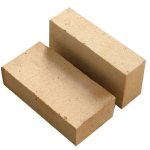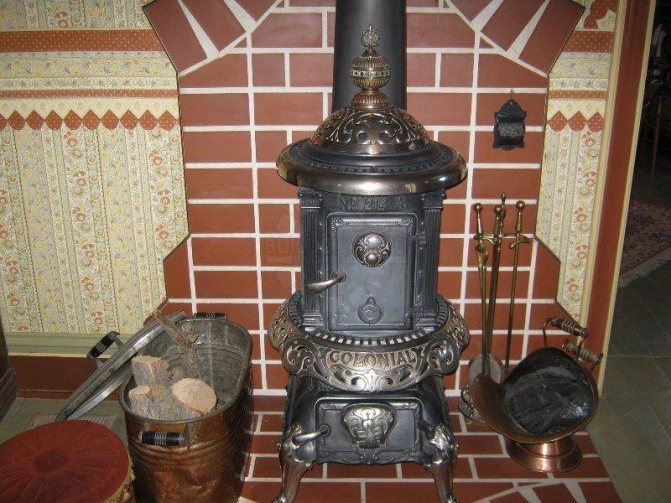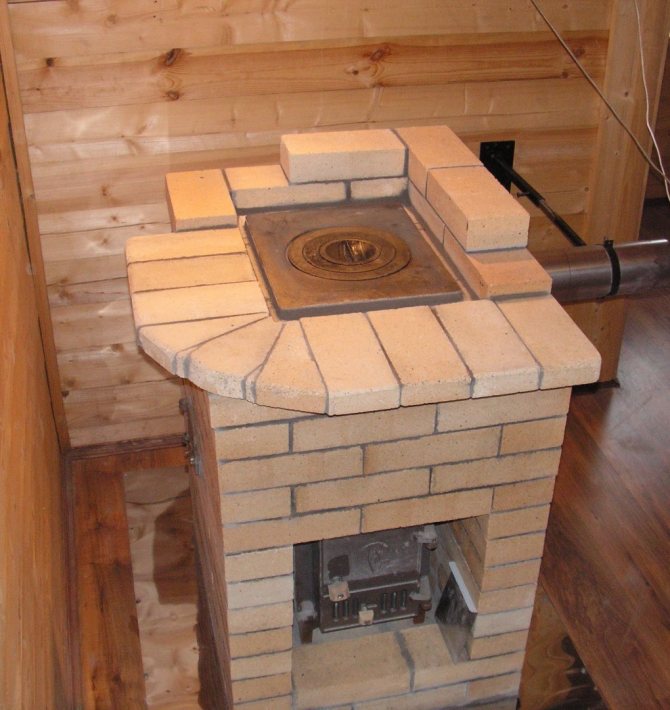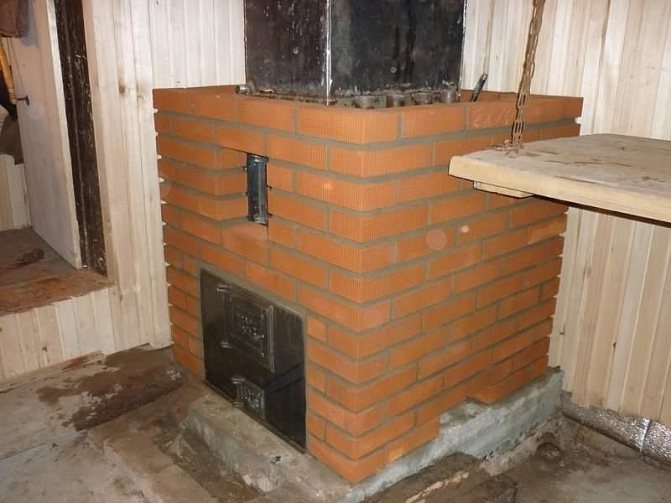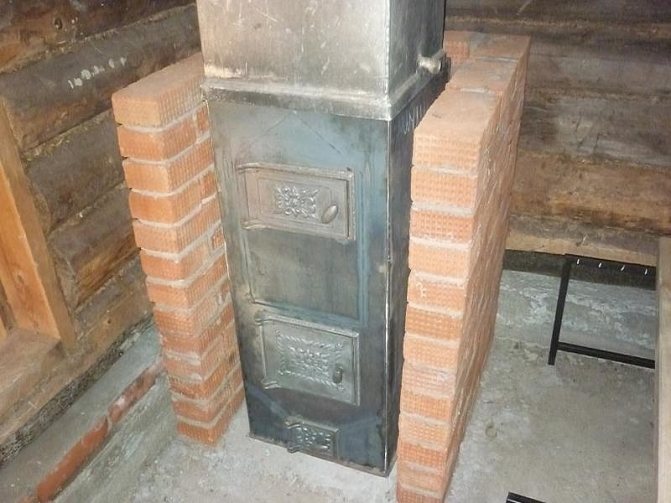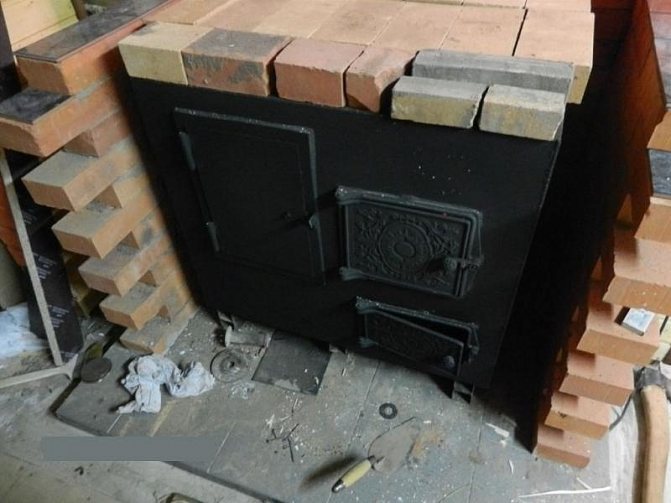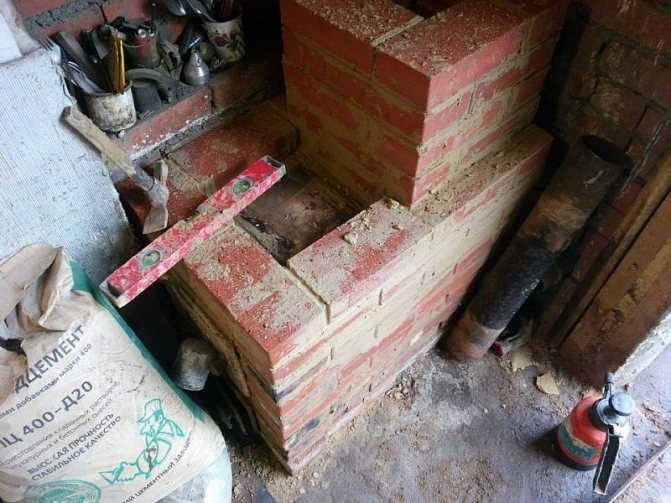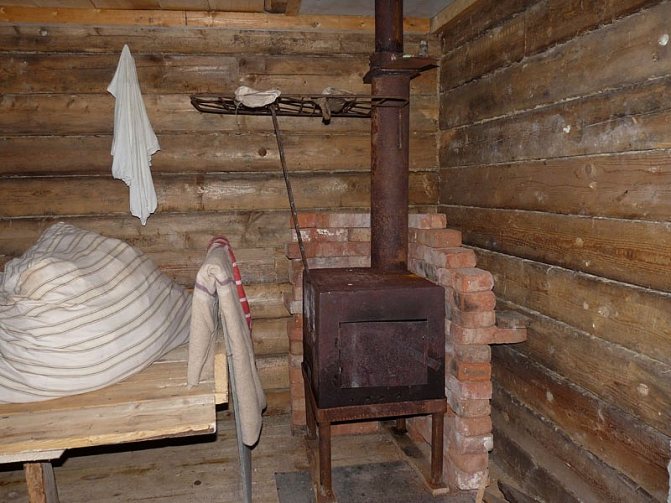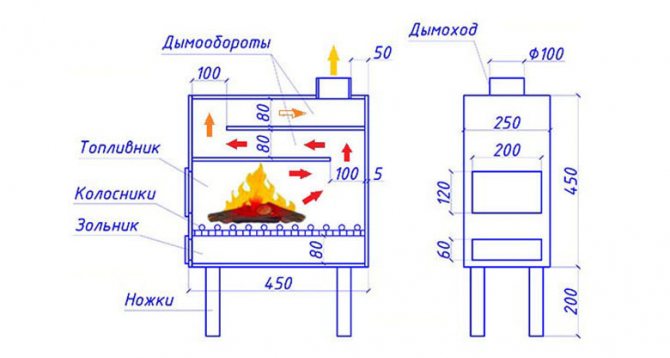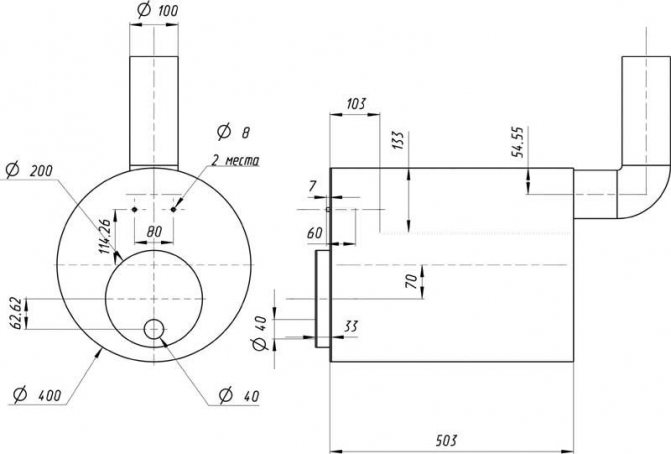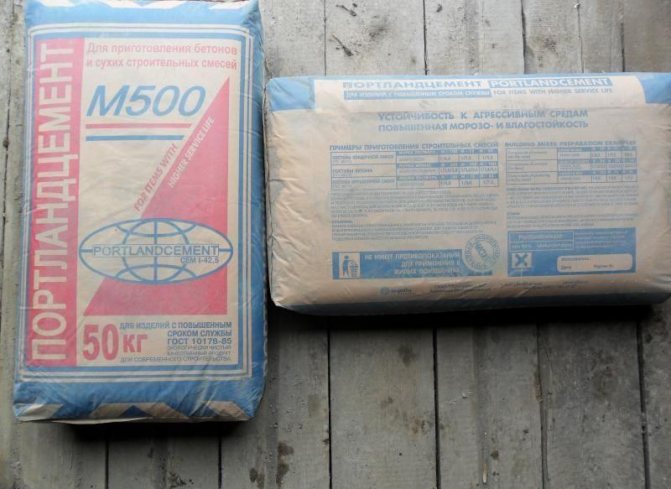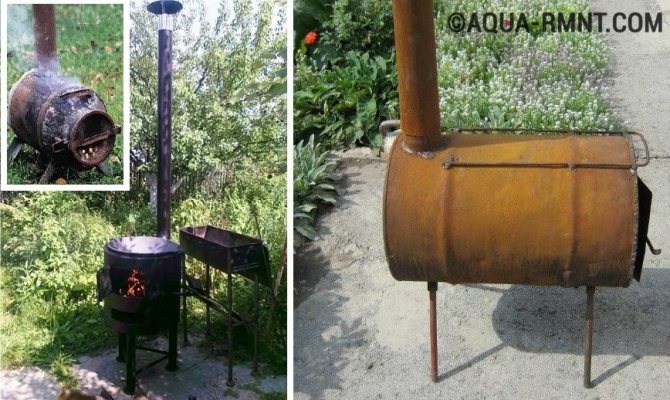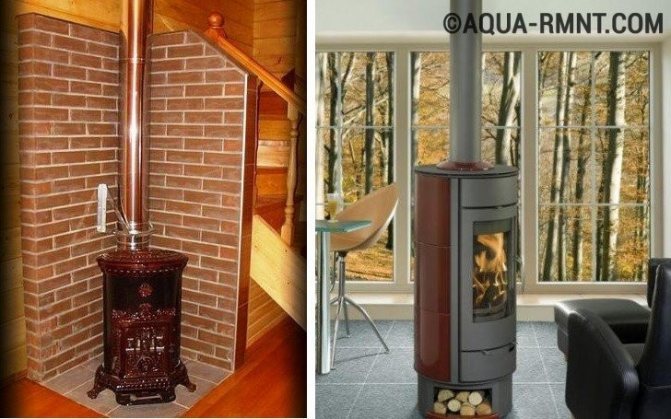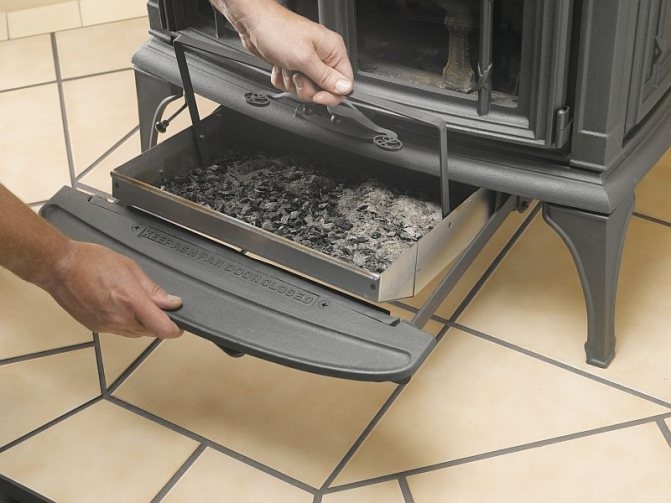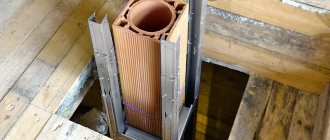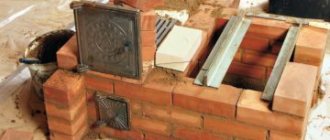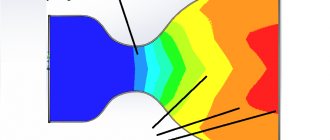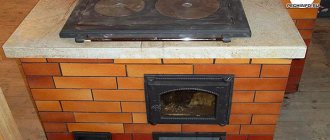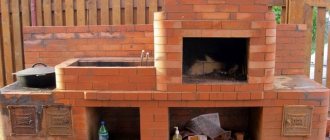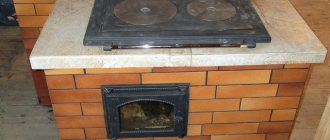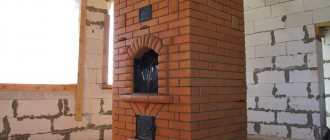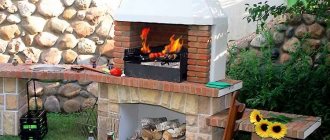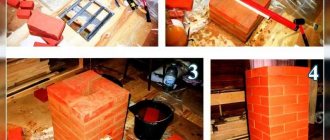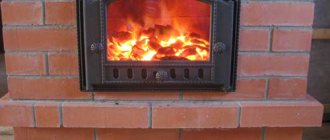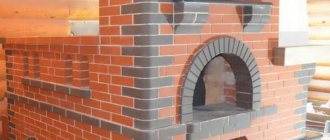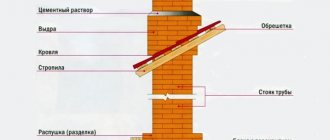Of all the benefits of civilization, the only one without which it is impossible to do without in a garage or in a country house in the cold season is heating.
A stove - a potbelly stove in these cases is indispensable, since almost any man can make it, and the materials necessary for manufacturing are easy to find at the nearest landfill or scrap metal reception base.
The stove can be made from an old can, and from an old metal barrel, and from sheet steel. You can also make a brick stove.
The resulting stove can be heated with almost anything, quickly warming up the room. But, unfortunately, the walls of the stove also quickly cool down if the fire in the firebox has already gone out.
In addition to this, a metal potbelly stove has several more disadvantages. It belongs to fire-hazardous structures, it burns out quickly, and if you accidentally touch its red-hot wall, you can get a serious burn.
Which brick to choose for masonry?
For each section of the furnace, use its own brick. The highest temperature in the firebox. The material must be able to withstand this load. Only fireclay bricks are suitable here.
All chimney ducts and the firebox area are also subjected to a temperature test, albeit not so high. Here we will use refractory ceramic bricks. It is cheaper than fireclay and is able to withstand the load.
As a base, we will use frost-resistant brick that can withstand high pressure. The weight of the entire structure will be distributed on it.
General recommendation - we use brick:
- corpulent;
- qualitative;
- with good heat dissipation and heat capacity.
The bricks must be of different sizes. Before buying, it is necessary to clarify under which order the order is calculated. Below you will find step-by-step instructions for laying a brick stove with your own hands. There you can use a brick with a size of 250x120x65. Also, it was he who was taken into account in the order in photo # 2 (below, in the section “Laying the stove”).
If desired, you can use various decorative types of bricks for cladding. This will give the stove a more aesthetic appearance.
In our case, you will need 60 pieces of refractory ceramic bricks and 35 pieces of fireclay bricks (taking into account possible losses).
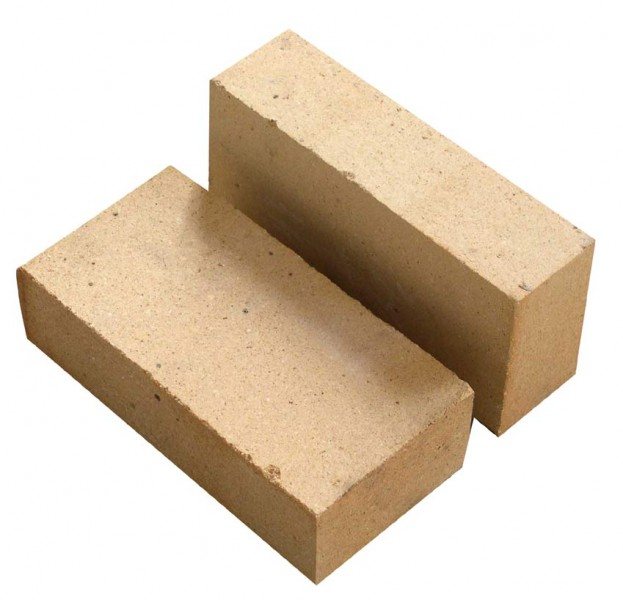
Preparation of the solution
Let's start by preparing the solution. For masonry work, we use a special ready-made mixture. Sold in hardware stores. It is a yellow-gray powder in 25 kg bags. It remains only to dilute with water in the correct ratio and mix. Detailed instructions are always indicated on the packaging, you need to follow it step by step. This solution is the best choice. He has only one drawback - the high price.
You can prepare a solution for masonry yourself. For this we need clay and sand. To begin with, we will determine the quality of the available clay and the content of impurities in it. Follow the instructions below:
- We roll the clay into a tourniquet. Thickness - 10-15 mm, length - 150-200 cm.
- Take a rolling pin with a diameter of 50 mm and wrap the tourniquet around it.
- The tourniquet should stretch smoothly and tear, stretching about 15-20%.
Expert opinion
Pavel Kruglov
Stove operator with 25 years of experience
If the tourniquet stretches more - the clay is "oily", it breaks earlier - "skinny". In the first version, the solution will shrink greatly under the influence of temperature, in the second it will crumble.
The next step is to prepare the sand. First we sift it through a fine sieve. The cell should not exceed 1.5x1.5 mm. Then follow the instructions:
- with the help of a holder and burlap, we arrange a kind of a net;
- pour sand into it and begin to rinse it under running water;
- rinse until the flowing water is clear.
Thus, we got rid of the sand from impurities.
We do the same with clay. Now it should be soaked. To do this, pour clay into a previously prepared container. Pour water so that the entire surface of the clay is covered. Mix thoroughly after 24 hours. We repeat the process until the clay is similar in consistency to toothpaste.
There is no universal proportion for mortar. Everything is established by trial and error, depending on the characteristics of the materials used. The main thing is that it is convenient to work with the solution.
To increase strength, experts recommend adding a little cement or salt.
Expert opinion
Pavel Kruglov
Stove operator with 25 years of experience
Here is a basic recipe for a masonry mortar:
We take 2 parts of clay. Add one sand to it. Using a construction mixer, mix until a homogeneous thick mass. We need about 40 liters of solution.
What tools and materials to prepare
To work with the selected material you will need:
- Master OK.
- A hammer.
- Grinding machine.
- Building level.
- Plumb line.
- Since it is necessary to cover the stove with a brick of high quality and safe, only red refractory material should be used.
We recommend that you read the material on the reasons for the smoke of the stove in addition to this article.
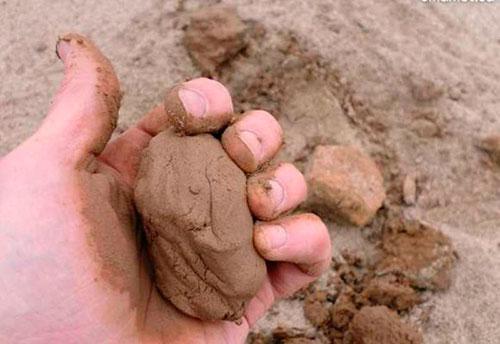

For mortar filling the joints, it is worth using a mixture of clay and sand.
One way to prepare a mix for fixing bricks is as follows:
- Different containers are filled with clay and sand in different proportions.
- The resulting mixture is left to dry for a couple of days.
- A cake is twisted from each solution, left for a while, so that the mixture "seizes".
- Dried material is thrown from a height of about a meter - if the mixture does not crumble, then it is of high quality.
We recommend reading about installing a brick oven in a wooden house in addition to this article.
This approach is time-consuming, but it guarantees that the selected proportions will be of the highest quality and most durable.
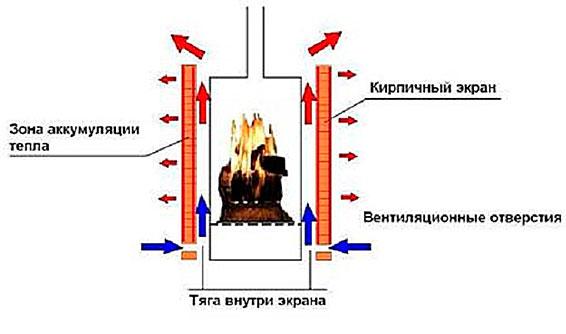

The diagram shows the main processes of air circulation
How to properly fold the stove stove?
Even a beginner can independently fold a brick stove-stove correctly. To do this, you need to know and follow the simple rules that pechnoy.guru provides below.
Scheme and drawing
Below we will consider how to fold a brick stove with your own hands. The drawing and dimensions can be seen in photo # 1:
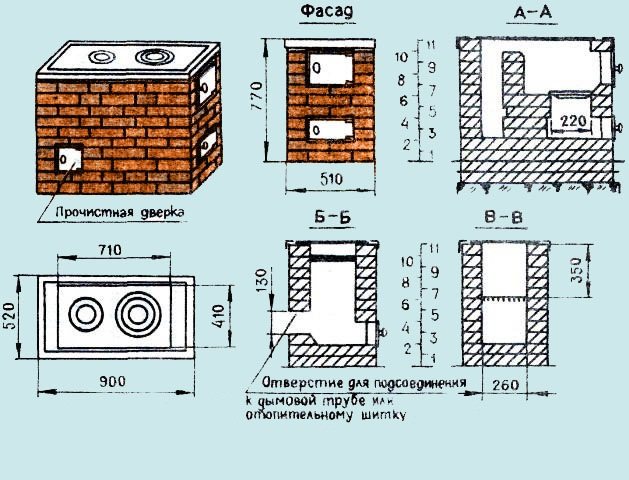

Photo number 1 - do-it-yourself brick stove drawing
The orderly layout of the bricks of the stove-stove from is shown in photo No. 2:
Photo No. 2 - ordinal layout of bricks (diagram)
We have decided on the materials and design of the furnace, the solution is ready. Such a construction does not require a foundation device. For comfortable and safe work, the heating must be placed in compliance with all fire safety standards. Having chosen a place, we stele two layers of waterproofing. From above we make a preparation of sand, 10 mm thick. Let's start laying:
- On top, without mortar, put a brick (see photo # 2, first row). We strictly control horizontality using a level.

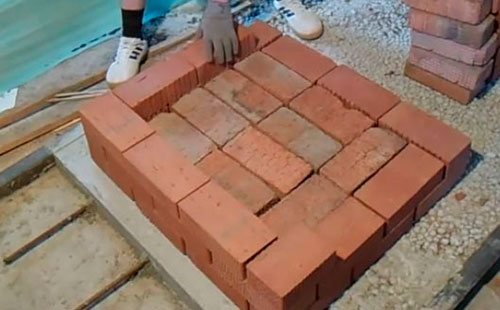
- Install the blower door. We fix it with a wire and wrap it with an asbestos cord.
- We continue laying (see photo # 2, row # 1).
- Next comes fireclay brick (see photo # 2). The grates will be installed above it.
- We put grates directly above the blower.

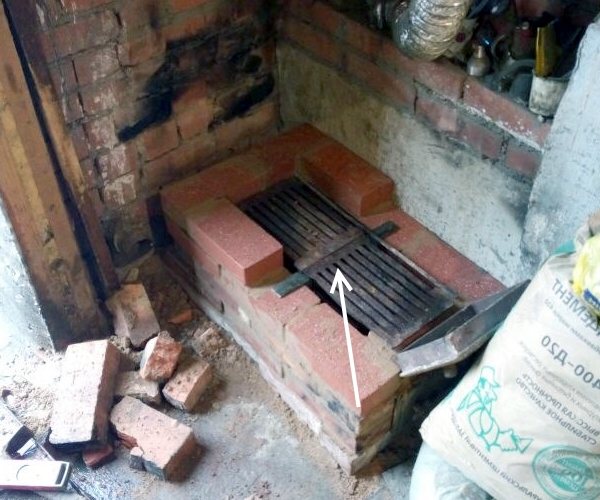
- We put the next row on spoons. We put the wall behind without mortar (knocked out bricks).
- Install the firebox door. We fix it with wire and bricks.
- Put a row on top of the bed along the contour of the fourth.
- The next one is back on the spoons.We put 2 bricks at the back.
- From above, the row should overlap the fire door and end 130 mm above it.
- We continue laying, slightly shifting the bricks back. Before that, we lay an asbestos cord, on which we will install the hob.

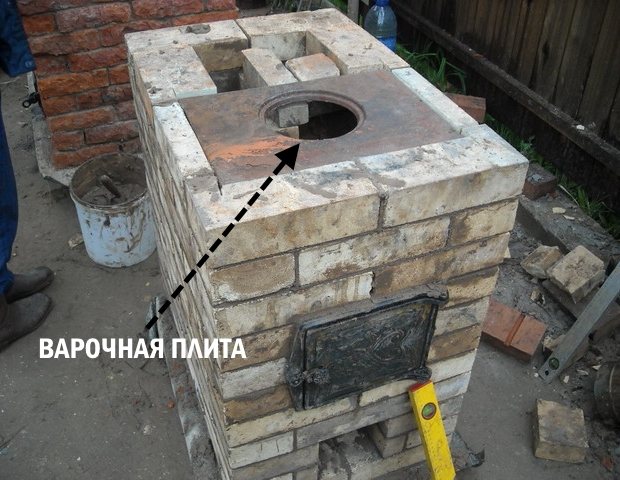
- Let's start the formation of the chimney from the next row. The design provides for the installation of a shell pipe made of sheet metal or corrugated aluminum. The pipe should not be heavy. Otherwise, the center of gravity may shift.
- On the eleventh row, we put a valve to regulate the air flow. Do not forget to seal it with an asbestos cord and cover it with clay.
- Next, we put the chimney in the quadruple, which we join with the metal one. The pipe should be strictly vertical and not bend to the side. For greater stability, it should be covered with three rows of bricks.

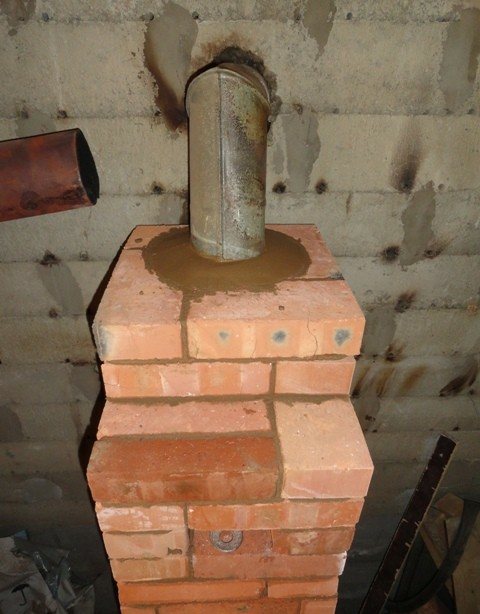
- We remove the knockout bricks that we put on the 4th row, we clean the chimney from debris.
- The oven should now be whitewashed. Any lime will go. Experts recommend adding blue and a little milk. So the whitewash will not darken and fly off.
- We install a metal sheet in front of the firebox.
- Install the skirting board.
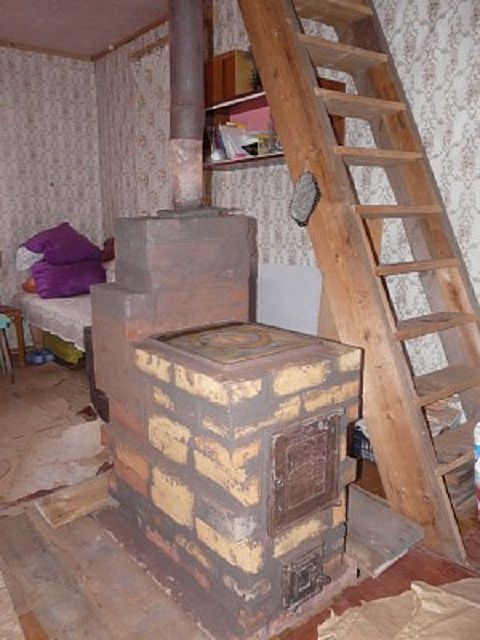

An example of a finished brick stove
Drying
The reason for the appearance of cracks is excess moisture in the bricks, so the oven must be thoroughly dried. There are two stages of drying: natural and forced.
- Natural drying lasts at least five days. All doors must be fully open. To increase the intensity of the process, put a fan in front of the firebox or put it into it and turn on an ordinary electric incandescent lamp (only not energy-saving). It will not be possible to completely dry the oven with this method, so we move on to the next step.
- Forced drying is performed by burning dry wood. Such a furnace is carried out once every 24 hours. You should only heat with small dry logs. Open the blower door and open the cover halfway.
When the wood burns out, cover the blower loosely. And close the top plug, leaving 1-2 cm. When the coals burn out, open all the channels. Carry out such a furnace within a week. On the first day, about 2 kg of firewood is burned. Then add 1 kg every day.
Making a door for the firebox
This element is the most difficult in the whole design. The following table shows the standardized dimensions of the oven doors:
| The size | Blowing, cleaning doors, mm | Openings for furnace doors, mm | |||
| length | 25 | 25 | 25 | 30 | 25 |
| width | 130 | 130 | 250 | 250 | 250 |
| height | 70 | 140 | 210 | 280 | 140 |
We make the firebox door according to the drawings shown in photo # 3:
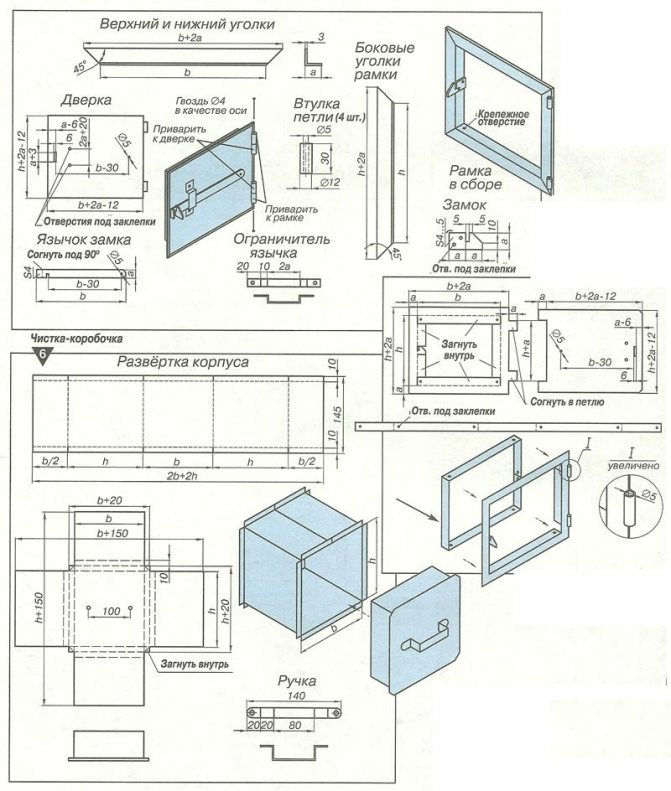

Photo No. 3 - drawing of the door for the firebox and cleaning chamber
Metal cladding
A brick stove can be additionally sheathed with metal. We get a metal potbelly stove with all the pluses, but no minuses (except for the weight). This design will protect the oven from cracking and chips. This will greatly increase the service life. This will require sheet metal, 4-6 mm thick. The process is not particularly difficult. The metal sheet is marked, the necessary parts are cut out with a grinder or a cutter. Then the facing is carried out and connected by welding and a metal corner.
This design is not only durable, but also safer. However, it requires additional costs and labor costs.
Installation and connection
When installing the furnace, you must strictly follow the fire safety rules:
- The distance to walls and surrounding objects must be at least 800 mm. Walls can also be covered with ceramic tiles.
- All parts of the chimney must be tightly connected.
- The room must be equipped with a supply and exhaust ventilation system.
The chimney is installed as follows:
- We fix the first pipe section above the chimney opening.
- We build up the pipe bends to the level of the overlap.
- In the overlap we make holes with a diameter of 170 mm. Remove the layer of thermal insulation around the hole in order to exclude fire.
- First, we mount the through glass, then insert the pipe into it.
- Next, we connect the pipes to the external chimney.
- We apply bitumen to the pipe and insulate it.
If you need to heat a large area, you can connect the stove to the heating shield. This will increase the heat flow and allow it to be stored longer.
Installing a stove in a country house
Before starting the installation, you need to choose a suitable place for the stove. It must be remembered that it should be kept away from all foreign surfaces and objects. At the same time, her work must always be monitored, which means she must be in sight.
The stove's legs are also made of metal, respectively, they are heated to a high temperature. You need to install the oven on
non-flammable base, like: concrete, ceramic tiles, brickwork, tin covering. You cannot put a potbelly stove on linoleum, laminate, soft flooring, plank floor, parquet, plastic.
Chimney pipes must be installed without connections within the same room. If such work is impossible, then the connection should be as tight as possible, the lower part of the pipe should "go" into the upper one. If the pipes provide for passage through walls, then you need to equip ceramic or brick thermal barrier... Fuel storage should be at a safe distance from the stove.
Features of operation
Expert opinion
Pavel Kruglov
Stove operator with 25 years of experience
The operation of such a stove is similar to that of a conventional brick stove. Although it does not retain heat as well. Therefore, a brick stove made with your own hands will have to be flooded again within 4-6 hours after the last coals have burned out.
This indicates the unprofitability of using such a design for constant heating. However, for heating a garage, summer residence, etc. periodically, it may well be used.
Such a furnace works only on solid fuel. This is another drawback.
At the same time, the design is easy to manufacture and operate. This explains its popularity.
Output
It is quite possible to make a brick stove made of brick yourself. Such a furnace increases the efficiency from 50-60% to 70-75%. However, it is still not cost-effective enough to fully replace stove heating. Although it is more efficient than iron, it retains heat, but for constant use it requires the connection of a heating shield.
As a temporary source of heat, a brick stove made with your own hands in a garage or greenhouse fully justifies itself.
The design can be further improved by revealing it with metal. This will increase the service life and protect the stove from damage.
Cast iron potbelly stove sheathed with brick
The characteristics of cast iron are such that stoves made from it do not require shielding. The heat capacity and thermal conductivity of cast iron structures are higher than those of steel products, but they are not devoid of the already mentioned disadvantages.
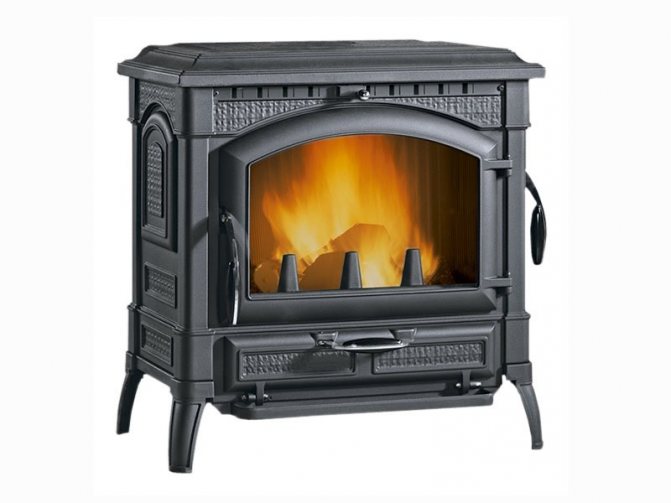

Cast iron potbelly stove has higher thermal conductivity
Bricklaying
Carrying out work in this case is somewhat simplified, since it is not required to organize a base for an installed cast-iron stove. In principle, the ordering is no different from the process described above.

